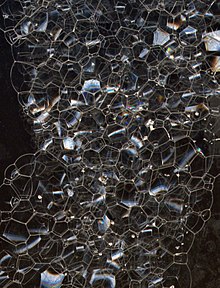Foam is a versatile material that plays a significant role in various industries and everyday products. It is a substance formed by trapping gas pockets in a liquid or solid, creating a structure with thin films separating the gas regions. This material is widely used due to its unique properties and applications across different sectors.
One of the most common types of foam is Polyurethane foam, which is extensively utilized in mattresses, furniture, and various other products. Polyurethane foam is known for its durability and support, with its density being a key factor in determining its quality. Foam density, measured in pounds per cubic foot, indicates how much foam is present in the material. Higher density foams offer more support and longevity, making them ideal for applications where durability is crucial.
Foam firmness, often measured using the Indent Load Deflection (ILD) test, determines how much foam compresses under pressure. The ILD rating reflects the amount of weight required to compress the foam by 25%, with higher ILD numbers indicating firmer foams. Understanding foam density and firmness is essential when selecting the right type of foam for specific uses, whether it be for mattresses, cushions, or other products.
In recent years, there has been a growing trend towards organic materials in foam production. Latex foam, derived from natural rubber tree sap or synthetic sources, offers a unique blend of characteristics that combine the pressure relief of memory foam with the responsiveness of traditional foams. Organic mattresses made from latex foam are gaining popularity due to their sustainable and eco-friendly nature.
Foam is also extensively used in building insulation materials, such as expanded polystyrene (EPS). Polystyrene foams are excellent thermal insulators and are commonly used in construction for their insulation properties. EPS, a closed-cell foam with high rigidity and toughness, is widely employed in various applications ranging from food containers to packaging materials.
The structure of foams can vary significantly depending on their intended use. Open-cell foams allow air and water to flow through them easily, making them suitable for applications where breathability is essential. In contrast, closed-cell foams have discrete gas pockets sealed within the material, making them impermeable to liquids and ideal for uses where water absorption must be minimized.
Foam technology continues to evolve, with ongoing research focusing on enhancing foam properties and developing innovative applications. From memory foams that adapt to body heat and pressure to high-density foams that provide exceptional support, the versatility of foam as a material makes it indispensable across a wide range of industries.
In conclusion, foam is a ubiquitous material found in everyday items like mattresses, cushions, insulation materials, and packaging products. Its diverse range of types and properties make it an essential component in various industries due to its durability, comfort, and insulating capabilities. The continuous innovation in foam manufacturing ensures that this versatile material will remain integral to numerous applications for years to come.
https://en.wikipedia.org/wiki/Foam
This article needs additional citations for verification. (February 2015) |
Foams are materials formed by trapping pockets of gas in a liquid or solid.



A bath sponge and the head on a glass of beer are examples of foams. In most foams, the volume of gas is large, with thin films of liquid or solid separating the regions of gas. Soap foams are also known as suds.
Solid foams can be closed-cell or open-cell. In closed-cell foam, the gas forms discrete pockets, each completely surrounded by the solid material. In open-cell foam, gas pockets connect to each other. A bath sponge is an example of an open-cell foam: water easily flows through the entire structure, displacing the air. A sleeping mat is an example of a closed-cell foam: gas pockets are sealed from each other so the mat cannot soak up water.
Foams are examples of dispersed media. In general, gas is present, so it divides into gas bubbles of different sizes (i.e., the material is polydisperse)—separated by liquid regions that may form films, thinner and thinner when the liquid phase drains out of the system films. When the principal scale is small, i.e., for a very fine foam, this dispersed medium can be considered a type of colloid.
Foam can also refer to something that is analogous to foam, such as quantum foam.
English
Etymology
From Middle English fom, foom, from Old English fām, from Proto-West Germanic *faim, from Proto-Germanic *faimaz, from Proto-Indo-European *(s)poHy-m-os, from *(s)poH(y)- (“foam”).